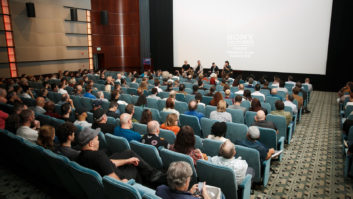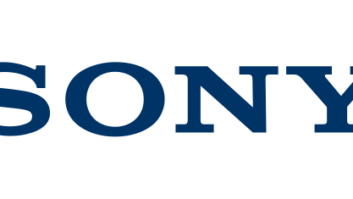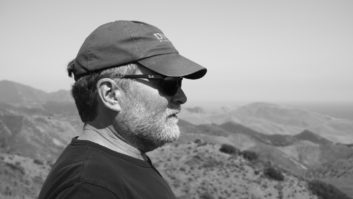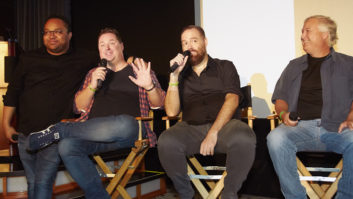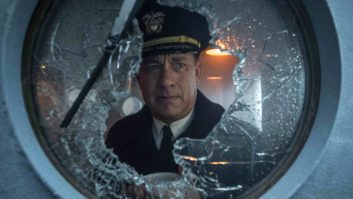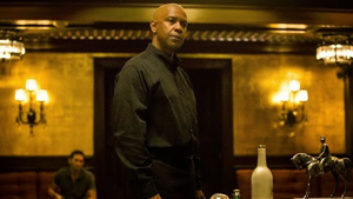The largest of Sony Pictures’ 10 rerecording stages, the 367-seat Cary Grant Theatre strives to meld the future with the best of the past. Remodeled in 2000 with an art deco motif, the theater now features a 288 full-channel Harrison MPC2 digital mixing console, along with an all-digital machine room.
As the flagship of a massive 10-year, studiowide renovation, the theater received aesthetic improvements and a technological overhaul. Over a three-month period, the room was completely stripped, and with the help of acoustic designer Ray Van Den Broeck and architects HLW International, the ceiling, walls and floor were redesigned, with an extensive use of granite and mood lighting. The stage area was enlarged to accommodate a larger console and workstations to each side, and a kitchen, two offices and new lounge were added.
Sony Pictures Post-Production Facilities president Michael J. Kohut has a special affinity for the Cary Grant Theatre; as a mixer, he has called it home for over nine years. Working on such films as Basic Instinct, Dead Poet’s Society and The Prince of Tides, and going back to War Games, Fame and Total Recall, Kohut garnered seven Best Sound Oscar nominations. He was the facility’s director of sound in 1989 when Sony Corp. purchased the studio.
“When Sony purchased the facility, we went on a 10-year program to renovate, establish new rooms and become all-digital,” Kohut explains. “We also wanted to develop new technologies that we could incorporate into the facility. Our plan was to renovate and to grow the business at the same time, which is difficult. We did it in small pockets of projects, and it worked very well. We are now in our eleventh year, and we are building our fifth new dubbing stage, which will come online in November.”
Recognizing that digital mixing was imminent, Kohut and his team collaborated with Harrison to create the MPC. “Since we needed to modernize the entire facility and put consoles in all of our stages, we ended up with eight Harrison analog MPCs,” Kohut says. “We didn’t want to have to go back to Sony Corp. in 10 years, after spending millions of dollars, and say, ‘Digital is right around the corner — now we’re going to have to put in all new consoles.’ Instead, with Harrison we developed the first console where the mixing surface was separated from the audio processing. We did it very successfully, and then Harrison worked on designing the digital aspect.”
The Cary Grant Theatre’s MPC2 features an 1120×1340 digital router, full digital metering, a 64×8 monitor matrix and 56 channels of PEC/direct switching, together with three sets of Harrison’s patented dual-motorized joysticks. The three-operator console stretches to almost 26 feet.
In addition to the MPC upgrade, additional control surface elements were added to the console, including four-layer-deep fader panels, digital meters and Harrison’s new I toys panel — a dedicated control panel with eight small motorized faders and other automation controls that function as a hardware controller for digital devices.
“A great feature of this console,” notes Mark A. Koffman, VP of engineering, “is that the console has been fully automated from inception. Now, with the digital engine, there’s no learning curve. Mixers can sit right down at it, and it works just like it did before.”
As part of the original plan to take the entire facility digital, Sony developed its own hard disk recorders, which in 2001 were honored with a Scientific and Engineering Academy Award. “We saw a need for digital recorders and reproducers when there wasn’t anything available,” says Koffman, “and we developed our own Sony DADR-5000 way back in 1994. Now we have something like 400 of them in our facilities. We have adopted the Pro Tools file format, so we have total interchangeability with any player at any facility in the world.”
Along with achieving the ultimate in state-of-the-art equipment, another equally important goal for the Sony post-production team has been to attract the highest level of mixing talent, including Kevin O’Connell, Greg P. Russell, Rick Kline, Scott Millan, Bob Beemer, Greg Watkins, Jeff Haboush, Gary Bourgeois, Greg Orloff and Bill Benton.
“We look for people who are both technically superior and who are very client-oriented,” says senior VP of sound, projection and video operations Richard Branca. “We have also been very instrumental in putting together teams. We try to promote from within, and then to create combinations with outside mixers who enhance our already wide client base.”
“We built the facility to be client-friendly,” concludes Kohut. “We range from 50 to 70 percent outside clients, and we’ve been fortunate to have the opportunity to do some of the biggest pictures in town. We’ve continued to grow every year, and we are enormously proud of our facility, our crews and our entire organization.”
